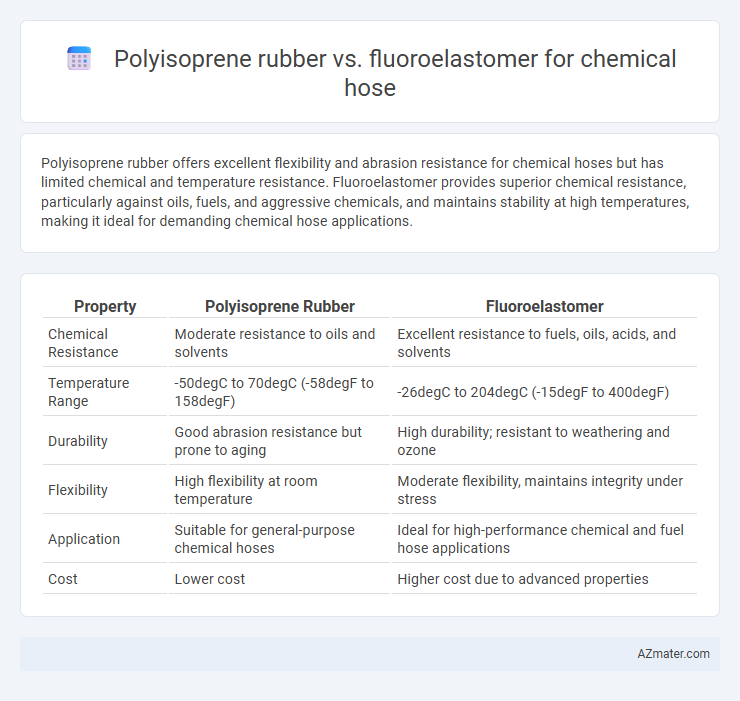Polyisoprene rubber offers excellent flexibility and abrasion resistance for chemical hoses but has limited chemical and temperature resistance. Fluoroelastomer provides superior chemical resistance, particularly against oils, fuels, and aggressive chemicals, and maintains stability at high temperatures, making it ideal for demanding chemical hose applications.
Table of Comparison
| Property | Polyisoprene Rubber | Fluoroelastomer |
|---|---|---|
| Chemical Resistance | Moderate resistance to oils and solvents | Excellent resistance to fuels, oils, acids, and solvents |
| Temperature Range | -50degC to 70degC (-58degF to 158degF) | -26degC to 204degC (-15degF to 400degF) |
| Durability | Good abrasion resistance but prone to aging | High durability; resistant to weathering and ozone |
| Flexibility | High flexibility at room temperature | Moderate flexibility, maintains integrity under stress |
| Application | Suitable for general-purpose chemical hoses | Ideal for high-performance chemical and fuel hose applications |
| Cost | Lower cost | Higher cost due to advanced properties |
Introduction: Polyisoprene Rubber vs Fluoroelastomer
Polyisoprene rubber offers excellent flexibility, resilience, and natural resistance to abrasion, making it suitable for chemical hose applications involving mild chemicals and low temperatures. Fluoroelastomer, known for its superior chemical resistance, high-temperature stability, and durability, is ideal for hoses exposed to aggressive chemicals, fuels, and extreme environments. Choosing between polyisoprene rubber and fluoroelastomer depends on specific chemical compatibility, operational temperature range, and mechanical performance requirements.
Chemical Hose Applications: Material Requirements
Polyisoprene rubber offers excellent elasticity and resilience, making it suitable for chemical hoses requiring flexibility and abrasion resistance in mild chemical environments. Fluoroelastomer excels in chemical hose applications demanding superior resistance to aggressive chemicals, high temperatures up to 200degC, and excellent durability in fuels, oils, and solvents. Material selection for chemical hoses prioritizes compatibility with specific chemicals, temperature tolerance, and long-term mechanical stability to ensure safe and reliable fluid transfer.
Polyisoprene Rubber: Key Properties and Benefits
Polyisoprene rubber offers exceptional tensile strength and flexibility, making it highly resistant to abrasion and mechanical stress in chemical hose applications. Its excellent elasticity and fatigue resistance ensure long service life under dynamic conditions, while its moderate chemical resistance suits hoses conveying non-aggressive fluids. Compared to fluoroelastomer, polyisoprene provides superior resilience and cost-effectiveness for hoses requiring robust physical performance in less chemically harsh environments.
Fluoroelastomer: Key Properties and Advantages
Fluoroelastomer offers exceptional chemical resistance, withstanding strong acids, bases, fuels, and solvents that degrade Polyisoprene rubber, making it ideal for chemical hose applications. Its superior thermal stability enables continuous operation in temperatures ranging from -25degC to 200degC, surpassing the limited temperature range of Polyisoprene. Enhanced durability against ozone, weathering, and compression set further positions Fluoroelastomer as the preferred material for long-lasting, high-performance chemical hoses in demanding industrial environments.
Chemical Resistance Comparison
Polyisoprene rubber offers moderate chemical resistance but is generally susceptible to degradation by oils, fuels, and solvents, limiting its use in aggressive chemical environments. Fluoroelastomers exhibit superior chemical resistance, with excellent stability against acids, bases, hydrocarbons, and most organic solvents, making them ideal for chemical hoses exposed to harsh chemicals. Selecting fluoroelastomer ensures extended hose lifespan and reliable performance in demanding chemical processing applications.
Temperature Tolerance and Performance
Polyisoprene rubber offers moderate temperature tolerance, typically ranging from -50degC to 70degC, making it suitable for applications with lower thermal demands. Fluoroelastomers excel with a broader temperature range of approximately -26degC to 205degC and superior resistance to aggressive chemicals, oils, and fuels, enhancing their performance in harsh environments. For chemical hoses requiring durability under extreme temperatures and exposure to solvents, fluoroelastomers provide enhanced chemical resistance and thermal stability compared to polyisoprene rubber.
Durability and Service Life
Polyisoprene rubber offers excellent flexibility and moderate chemical resistance, making it suitable for less aggressive environments but generally exhibits lower durability and shorter service life when exposed to harsh chemicals. Fluoroelastomer, known for its superior chemical resistance and high-temperature stability, significantly enhances the durability and extends the service life of chemical hoses used in aggressive solvents, acids, and fuels. The inherent resistance to swelling, abrasion, and chemical degradation in fluoroelastomers results in longer maintenance intervals and reduced replacement costs compared to polyisoprene rubber.
Cost Efficiency and Economic Considerations
Polyisoprene rubber offers significantly lower material and manufacturing costs compared to fluoroelastomer, making it a cost-efficient choice for chemical hose applications with moderate chemical exposure. Fluoroelastomer, while more expensive, provides superior chemical resistance and durability, reducing maintenance and replacement expenses in aggressive environments. Economic considerations must balance upfront cost savings of polyisoprene against the long-term cost benefits of fluoroelastomer's enhanced performance and extended service life.
Industry Standards and Certifications
Polyisoprene rubber and fluoroelastomer hoses are commonly evaluated under industry standards such as ASTM D2000 and ISO 23936-1, with fluoroelastomers typically excelling in chemical resistance and high-temperature applications, meeting stringent certifications like FDA and NSF for food-grade and potable water use. Fluoroelastomer hoses also comply more readily with standards such as SAE J517 for hydraulic hose and API 671 for refinery service due to superior chemical stability and durability. Polyisoprene, while compliant with some ASTM standards, is less favored in aggressive chemical environments and often lacks certifications required for harsh industrial applications, limiting its use in highly demanding sectors.
Choosing the Best Material for Chemical Hoses
Polyisoprene rubber offers excellent flexibility and resilience for chemical hoses but has limited resistance to oils, fuels, and aggressive chemicals compared to fluoroelastomer, which provides superior chemical resistance, thermal stability, and durability in harsh environments. Fluoroelastomer hoses withstand a broader range of solvents, acids, and elevated temperatures, making them ideal for demanding industrial applications involving aggressive chemicals. Choosing the best material involves evaluating the specific chemical compatibility, temperature range, and mechanical requirements of the hose application to ensure safety and longevity.

Infographic: Polyisoprene rubber vs Fluoroelastomer for Chemical hose
 azmater.com
azmater.com